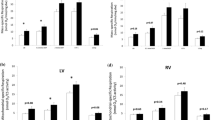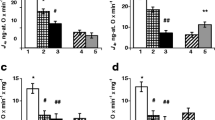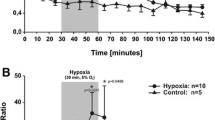Abstract
The energy metabolism was evaluated in gastrocnemius muscle from 3-month-old rats subjected to either mild or severe 4-week intermittent normobaric hypoxia. Furthermore, 4-week treatment with CNS-acting drugs, namely, α-adrenergic (δ-yohimbine), vasodilator (papaverine, pinacidil), or oxygen-increasing (almitrine) agents was performed. The muscular concentration of the following metabolites was evaluated: glycogen, glucose, glucose 6-phosphate, pyruvate, lactate, lactateto-pyruvate ratio; citrate, α-ketoglutarate, succinate, malate; aspartate, glutamate, alanine; ammonia; ATP, ADP, AMP, creatine phosphate. Furthermore the Vmax of the following muscular enzymes was evaluated: hexokinase, phosphofructokinase, pyruvate kinase, lactate dehydrogenase; citrate synthase, malate dehydrogenase; total NADH cytochrome c reductase; cytochrome oxidase. The adaptation to chronic intermittent normobaric mild or severe hypoxia induced alterations of the components in the anaerobic glycolytic pathway [as supported by the increased activity of lactate dehydrogenase and/or hexokinase, resulting in the decreased glycolytic substrate concentration consistent with the increased lactate production and lactate-to-pyruvate ratio] and in the mitochondrial mechanism [as supported by the decreased activity of malate dehydrogenase and/or citrate synthase resulting in the decreased concentration of some key components in the tricarboxylic acid cycle]. The effect of the concomitant pharmacological treatment suggests that the action of CNS-acting drugs could be also related to their direct influence on the muscular biochemical mechanisms linked to energy transduction.
Similar content being viewed by others
References
Pastoris, O., Dossena, M., Gorini, A., Vercesi, L., and Benzi, G. 1985. Adaptation of skeletal muscle energy metabolism to repeated hypoxic-normoxic exposures and drug treatment. Arch. Int. Pharmacodyn. 274:145–158.
Pastoris, O., Vercesi, L., Allorio, F., and Dossena, M. 1988. Effect of hypoxia, aging and pharmacological treatment on muscular metabolites and enzyme activities. Il Farmaco Ed. Sc. 53:627–642.
Pastoris, O., Dossena, M., Allorio, F., and Vercesi, L. 1990. Hypoxia and pharmacological treatment in differently aged rats: effect on muscular metabolite concentrations. Mech. Aging Dev. 54: 207–219.
Karpati, G., Carpenter, S., Melmed, C., and Eisen, A. A. 1974. Experimental ischemia myopathy. J. Neurol. Sci. 23:129–161.
Aschenbrenner, V., Albin, R., Zak, R., Nair, K. G., and Rabinowitz, M. 1972. Pages 178–185,in Bajusz, E., and Rona, G. (eds.), Myocardiology, Urban & Schwarzenberg, München.
Alberghina, M., Cambria, A., Petrone, G., and Mistretta, A. 1977. In vivo incorporation of3H-glycerol and14C-palmitate into lipids of subcellular fractions of the myocardium hypertrophied during experimental hypoxia. Ital. J. Biochem. 26:331–341.
Schreiber, S. S., Oratz, M., Evans, C., and Gueyikian, F. 1970. Myosin, myoglobin, and collagen synthesis in acute cardiac overload. Amer. J. Physiol. 219:481–486.
Jefferson, L. S., Wolpert, E. B., Giger, K. E., and Morgan, H. E. 1971. Regulation of protein synthesis in heart muscle. III. Effect of anoxia on protein synthesis. J. Biol. Chem. 246:2171–2178.
Dunlop, D. S. 1978. Measuring protein synthesis and degradation rates in CNS tissue. Vol. 4, Pages 91–138,in Marks, K., Rodnight, R. (eds.), Research Methods in Neurochemistry, Plenum Press, New York.
Marzatico, F., Curti, D., Dagani, F., Taglietti, M., and Benzi, G. 1986. Brain enzyme adaptation to mild normobaric intermittent hypoxia. J. Neurosci. Res. 16:419–428.
Villa, R. F., Turpeenoja, L., Magrl, G., Gorini, A., Ragusa, N., and Giuffrida-Stella, A. M. 1991. Effect of hypoxia on protein composition of synaptic membranes from cerebral cortex during aging. Neurochem. Res. 16:827–832.
Serra, I., Alberghina, M., Viola, M., and Giuffrida, A. M. 1981. Effect of hypoxia on nucleic acids and protein synthesis in different brain regions. Neurochem. Res. 6:595–605.
Alberghina, M., and Giuffrida, A. M. 1981. Effect of hypoxia on the incorporation of [1-14C] palmitate on lipids of various brain regions. J. Neurosci. Res. 6:403–419.
Alberghina, M., Viola, M., and Giuffrida, A. M. 1982. Changes in enzyme activities of glycerolipid metabolism of guinea pig cerebral hemispheres during experimental hypoxia. J. Neurosci. Res. 7:147–154.
Wollenberger, A., Ristau, O., and Schoffe, G. 1960. Eine einfache Technik der extrem schnellen Abkuhlung grosserer Gewebestucke. Pflügers Arch. 270:399–412.
Keppler, D., and Decker, K. 1974. Glycogen. Determination with amyloglucosidase. Pages 1127–1131,in Bergmeyer, H. U. (ed.), Methods of Enzymatic Analysis, Academic Press Inc., New York and London.
Bergmeyer, H. U., Bernt, E., Schmidt, F., and Stork, H. 1974. D-glucose. Determination with hexokinase and glucose-6-phosphate dehydrogenase. Pages 1196–1201,in Bergmeyer, H. U. (ed.), Methods of Enzymatic Analysis, Academic Press Inc., New York and London.
Passonneau, J. V., and Lowry, O. H. 1974. Pyruvate. Pages 1452–1456,in Bergmeyer, H. U. (ed.), Methods of Enzymatic Analysis, Academic Press Inc., New York and London.
Lowry, O. H., and Passonneau, J. V. 1972. Lactate. Pages 194–199,in A Flexible System of Enzymatic Analysis, Academic Press Inc., New York and London.
Lowry, O. H., and Passonneau, J. V. 1972. Citrate. Pages 157–158,in A Flexible System of Enzymatic Analysis, Academic Press Inc., New York and London.
Narins, R. G., and Passonneau, J. V. 1974. 2-Oxoglutarate. Fluorimetric determination. Pages 1580–1584,in Bergmeyer, H. U. (ed.), Methods of Enzymatic Analysis, Academic Press Inc., New York and London.
Lowry, O. H., and Passonneau, J. V. 1972. Malate. Pages 201–203,in A Flexible System of Enzymatic Analysis, Academic Press Inc., New York and London.
Bergmeyer, H. U., Bernt, E., Mollering, H., and Pfleiderer, G. 1974. L-aspartate and L-asparagine. Pages 1696–1700,in Bergmeyer, H. U. (ed.), Methods of Enzymatic Analysis, Academic Press Inc., New York and London.
Witt, I. 1974. L-Glutamate. Determination with glutamate dehydrogenase and the 3-acetylpyridine analogue of NAD (APAD). Pages 1713–1715,in Bergmeyer, H. U. (ed.), Methods of Enzymatic Analysis, Academic Press Inc., New York and London.
Williamson, D. H. 1974. L-Alanine. Determination with alanine dehydrogenase. Pages 1679–1682,in Bergmeyer, H. U. (ed.), Methods of Enzymatic Analysis, Academic Press Inc., New York and London.
Kun, E., and Kearney, E. B. 1974. Ammonia. Pages 1802–1806,in Bergmeyer, H. U. (ed.), Methods of Enzymatic Analysis, Academic Press Inc., New York and London.
Lamprecht, W., Stein, P., Heinz, P., and Weisser, H. 1974. Creatine phosphate. Determination with creatine kinase, hexokinase and glucose-6-phosphate dehydrogenase. Pages 1777–1781,in Bergmeyer H. U. (ed.), Methods of Enzymatic Analysis, Academic Press Inc., New York and London.
Jaworek, D., Gruber, W., and Bergmeyer, H. U. 1974. Adenosine-5′-diphosphate and adenosine-5′-monophosphate. Pages 2127–2131,in Bergmeyer, H. U. (ed.), Methods of Enzymatic Analysis, Academic Press Inc., New York and London.
Atkinson, D. E. 1968. The energy charge of the adenylate pool as regulatory parameter. Interaction with feed-back modifiers. Biochemistry 7:4030–4034.
Lowry, Q. H., Rosebrough, N. J., Farr, A. L., and Randall, E. J. 1951. Protein measurement with the folin phenol reagent. J. Biol. Chem. 193:265–275.
Easterby, J. S., and Qadri, S. S. 1982. Hexokinase type II from rat skeletal muscle. Vol. 90, pages 11–15,in Colowick, S. P., and Kaplan, N. O. (eds.), Methods in Enzymology, Academic Press Inc., New York and London.
Sugden, P. H., and Newsholme, E. A. 1975. The effects of ammonium, inorganic phosphate and potassium ions on the activity of phosphofructokinases from muscle and tissues of vertebrates and invertebrates. Biochem. J. 150:113–122.
Bergmeyer, H. U., and Bernt, E. 1974. Pyruvate kinase. Pages 509–510,in Bergmeyer, H. U. (ed.), Methods of Enzymatic Analysis, Academic Press Inc., New York and London.
Bergmeyer, H. U., and Bernt, E. 1974. Lactate dehydrogenase. UV-assay with pyruvate and NADH. Pages 574–579,in Bergmeyer, H. U. (ed.), Methods of Enzymatic Analysis, Academic Press Inc., New York and London.
Srere, P. A. 1969. Citrate synthase. Pages 3–11,in Colowick, S. P., and Kaplan, N. O. (eds.), Methods in Enzymology, Academic Press Inc., New York and London.
Ochoa, S. 1955. Malic dehydrogenase from pig heart, Pages 735–739,in Colowick, S. P., and Kaplan, N. O. (eds.), Methods in Enzymology, Academic Press Inc., New York and London.
Smith, L. 1955. Spectrophotometric assay of cytochrome c oxidase. Pages 427–434,in Glick, D. (ed.), Methods of Biochemical Analysis, Wiley Interscience, New York.
Wharton, D. C., and Tzagoloff, A. 1967. Cytochrome oxidase from beef heart mitochondria. Pages 245–250,in Colowick S. P., and Kaplan N. O. (eds.). Methods in Enzymology, Academic Press Inc., New York and London.
Nason, A., and Vasington, F. D. 1963. Lipid-dependent DPNH-cytochrome c reductase from mammalian skeletal and heart muscle. Pages 409–415,in Colowick S. P., and Kaplan N. O. (eds.), Methods in Enzymology, Academic Press Inc., New York and London.
Roquebert, J., and Demichel, P. 1985. Inhibition of the alpha1 and alpha2 adrenoreceptor mediated pressor response in pithed rats by raubasine, tetrahydroalostonine and akuammigine. Eur. J. Pharmacol. 106:203–205.
Roquebert, J., Gomond, P., and Demichel, P. 1981. Antinoradrenergic activity of raubasine on isolated thoracic aorta and vas deferens of rats. J. Pharmacol. 12:393–403.
Demichel, P., and Roquebert, J. 1984. Effects of raubasine stereoisomers on pre- and postsynaptic alpha-adrenoreceptors in the rat vas deferens. Br. J. Pharmacol. 83:505–510.
Aghajanian, G. K., and Rogawski, M. A. 1983. The physiological role of alpha-adrenoreceptors in the central nervous system: new concepts from single cells studies. TIPS 4:315–317.
Sebban, C., Tesolin, B., and Guez, D. 1987. Electroencéphalogramme quantifié: intérêt dans l'évaluation d'une thérapeutique du vieillissement cérébral. Prosse Méd. 16:1154–1158.
Sebban, C., Tesolin, B., Coulomb, B., and Berthaux, P. 1989. Comparative effects of almitrine and raubasine, singly and in combination, on electroencephalographic activity in young and old rats. Exp. Gerontol. 24:11–24.
Benzi, G., Gorini, A., Ghigini, B., Arnaboldi, R., and Villa, R. F. 1993. Synaptosomal non-mitochondrial ATPase activities and drug treatment. Neurochem. Res. 18:719–726.
Benzi, G., Gorini, A., Ghigini, B., Arnaboldi, R., and Villa, R. F. 1994. Modifications by hypoxia and drug treatment on cerebral ATPase plasticity. Neurochem. Res. 19:517–524.
Nedergaard, O. A. 1985. Pre- and postjunctional effects of pinacidil on sympathetic neuroeffector transmission in rabbit blood vessels. Br. J. Pharmacol. 85 (Suppl.):338P.
Petersen, H. J., Kaergaard Nielsen C., and Arrigoni-Martelli, E. 1978. Synthesis and hypotensive activity of N-alkyl-N″-cyano-N′-pyridylguanidines. J. Med. Chem. 21:773–781.
Friedel, H. A., and Brogden, R. N. 1990. Pinacidil. A review of its pharmacodynamic and pharmacokinetic properties, and therapeutic potential in the treatment of hypertension. Drugs 39:929–967.
Hamilton, T. C., Weston, A. H. 1989. Cromakalim, nicorandil and pinacidil; novel drugs which open potassium channels in smooth muscle. Gen. Pharmacol. 20:1–9.
Eltze, M. 1989. Glibenclamide is a competitive antagonist of cromakalim, pinacidil and RP 49356 in guinea-pig pulmonary artery. Eur. J. Pharmacol. 165:231–239.
Bray, K. M., Newgreen, D. T., Small, R. C., Southerton, J. S., and Taylor, S. G. 1987. Evidence that the mechanism of the inhibitory action of pinacidil in rat and guinea-pig smooth muscle differs from that of glyceryl trinitrate. Br. J. Pharmacol. 91:421–429.
Quast, U., and Cook, N. 1987. Comparison of BRL34915 and pinacidil in the guinea-pig portal vein. Naunyn-Schmiedeberg's Arch. Pharmacol. 335 (Suppl.):R64.
Weston, A. H., Bray, K. M., Duty, S., McHarg, A. D., Newgreen, D. T., and Southerton, J. S. 1988. In vitro studies on the mode of action of pinacidil. Drugs 36 (Suppl. 7):10–28.
Weston, A. H., Southerton, J. S., Bray, K. M., Newgreen, D. T., and Taylor, S. G. 1988. The mode of action of pinacidil and its analogs P1060 and P1368: results of studies in rat blood vessels. J. Cardiovasc. Pharmacol. 12 (Suppl. 2):S10-S16.
Laubie, M. 1982. Effects of almitrine bismesylate on gas exchange and ventilation in the anesthetized dog. Bull. Eur. Physiopath. Resp. 18:279–284.
Labrid, C. 1982. Current concepts on almitrine bismesylate mechanism of action. Bull. Eur. Physiopath. Resp. 18:299–306.
Laubie, M., Drouillat, M., and Schmitt, H. 1983. Nucleus tractus solitarii respiratory neurons in the chemoreceptor pathway activated by almitrine. Eur. J. Pharmacol. 93:87–93.
Laubie, M., Drouillat, M., and Schmitt, H. 1984. Ventrolateral medullary respiratory neurons and peripheral chemoreceptor stimulation by almitrine. Eur. J. Pharmacol. 102:437–442.
Author information
Authors and Affiliations
Rights and permissions
About this article
Cite this article
Pastoris, O., Dossena, M., Foppa, P. et al. Modifications by chronic intermittent hypoxia and drug treatment on skeletal muscle metabolism. Neurochem Res 20, 143–150 (1995). https://doi.org/10.1007/BF00970538
Accepted:
Issue Date:
DOI: https://doi.org/10.1007/BF00970538




